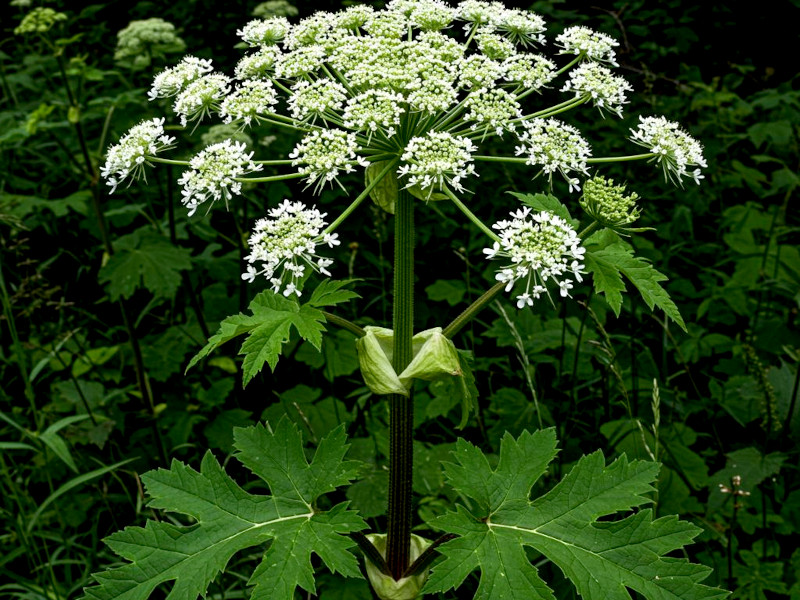Wise Mind Herbs
Evidence-based Herbal Healing
The information on this page has been prepared with reference to published scientific literature, not by a medically qualified expert. It is not medical advice. Any decision to use a supplement or herb-based product is your responsibility. Consult a suitably qualified medical professional, especially if you have underlying conditions. Remember, nothing is for everyone, and not everything sold is what it claims to be. Some things work for some people, some of the time.
Hogweed - Heracleum sphondylium
It's important to first clarify that Heracleum sphondylium (common hogweed) should not be confused with Heracleum mantegazzianum (giant hogweed), which is known to cause severe photodermatitis. Common hogweed is also known as cow parsnip, eltrot, or hogwort in various regions.
Based on the current scientific literature, I must caution that there is a significant lack of robust clinical research on Heracleum sphondylium specifically. Most studies are preliminary, focusing on in vitro or animal models, with very few well-designed human clinical trials.

Potential Health Benefits
The limited research suggests Heracleum sphondylium may have the following properties:
- Anti-inflammatory effects, primarily observed in laboratory studies
- Antioxidant activity due to the presence of flavonoids and phenolic compounds
- Antimicrobial properties against certain bacteria in in vitro studies
- Mild analgesic (pain-relieving) effects in preliminary animal studies
It's crucial to note that none of these potential benefits have been conclusively proven in clinical settings with human subjects, and the plant is not recognized by major health authorities as a treatment for any medical condition.
Traditional Uses
In traditional European folk medicine, Heracleum sphondylium has historically been used for:
- Digestive complaints
- Respiratory conditions
- Topical application for skin conditions
- As a diuretic
However, these traditional uses lack scientific validation through modern clinical trials.
Recommended Dosages
Due to insufficient clinical research, there are no scientifically established or standardized dosages for Heracleum sphondylium. The lack of standardization of active compounds in commercially available preparations further complicates dosage recommendations.
No studies have systematically investigated dose-response relationships or determined maximum efficacious ranges, representing a significant knowledge gap in the scientific literature.
Active Compounds
The plant contains several bioactive compounds, including:
- Furanocoumarins (psoralen, bergapten, xanthotoxin)
- Flavonoids (quercetin, kaempferol derivatives)
- Essential oils (primarily monoterpenes and sesquiterpenes)
- Phenolic acids
The specific concentrations of these compounds can vary significantly based on growing conditions, plant part used, and harvesting time.
Side Effects and Disbenefits
The primary concern with Heracleum sphondylium is its furanocoumarin content, which can cause:
- Phytophotodermatitis – a skin reaction when exposed to sunlight after contact with plant sap
- Contact dermatitis in sensitive individuals
- Potential gastric irritation when consumed
- Possible interactions with medications, particularly those affected by cytochrome P450 enzymes
Pregnant and breastfeeding women should avoid using hogweed due to insufficient safety data. Similarly, individuals with photosensitivity disorders or those taking photosensitizing medications should exercise caution.
Similar Species and Confusion
Heracleum sphondylium is often confused with other Apiaceae family members:
- Heracleum mantegazzianum (giant hogweed) – highly toxic with severe phototoxic reactions
- Heracleum sosnowskyi (Sosnowsky's hogweed) – also highly phototoxic
- Angelica archangelica (garden angelica) – has similar appearance but different properties
- Pastinaca sativa (wild parsnip) – can also cause phytophotodermatitis
This confusion between species presents significant safety concerns, as misidentification could lead to serious adverse effects.
Commercial Pharmaceutical Products
There are currently no approved pharmaceutical medications containing Heracleum sphondylium extracts or synthesized homologues in major markets including the US, EU, UK, or Canada. The plant primarily appears in herbal supplements and traditional preparations rather than registered pharmaceutical products.
Research Gaps
Significant knowledge gaps exist regarding:
- Clinical efficacy for any medical condition
- Pharmacokinetics and pharmacodynamics of active compounds
- Long-term safety profile
- Standardization of preparation methods
- Appropriate dosing strategies
- Drug interactions
Conclusion
The current scientific evidence does not support the use of Heracleum sphondylium for treating or alleviating any specific medical conditions. The potential risks, particularly phototoxicity, may outweigh any theoretical benefits. Individuals interested in herbal remedies should consult healthcare providers and consider options with better-established safety and efficacy profiles.
References
Bahadori, M. B., Dinparast, L., & Zengin, G. (2016). The genus Heracleum: a comprehensive review on its phytochemistry, pharmacology, and ethnobotanical values as a useful herb. Comprehensive Reviews in Food Science and Food Safety, 15(6), 1018-1039.
Kose, T. I., Yardimci, G. B., Kirci, D., Polat, D. C., Demirci, B., Eryilmaz, M., & Kilic, C. S. (2025). Bioactivities and Chemotaxonomy of Four Heracleum Species: A Comparative Study Across Plant Parts. Pharmaceuticals, 18(4), 576.
Kurtul, E., Küpeli Akkol, E., Karpuz Ağören, B., Yaylacı, B., Bahadır Acıkara, Ö., & Sobarzo-Sánchez, E. (2025). Phytochemical investigation and assessment of the anti-inflammatory activity of four Heracleum taxa growing in Turkey. Frontiers in Pharmacology, 15, 1494786.
Matejic, J. S., Dzamic, A. M., Mihajilov-Krstev, T., Ristic, M. S., Randelovic, V. N., Krivošej, Z. Ð., & Marin, P. D. (2016). Chemical Composition, Antioxidant and Antimicrobial Properties of Essential Oil and Extracts from Heracleum sphondylium L. Journal of Essential Oil Bearing Plants, 19(4), 944-953.